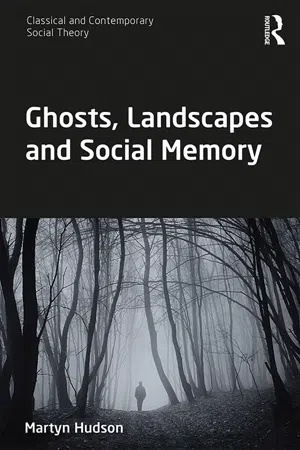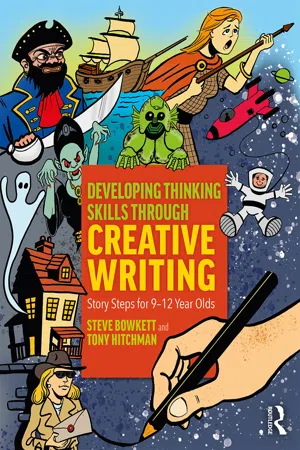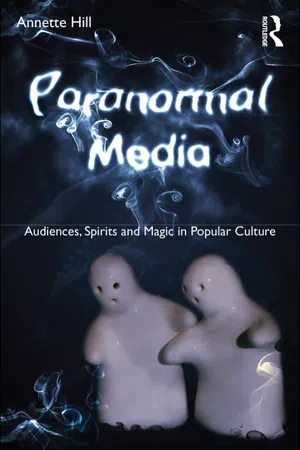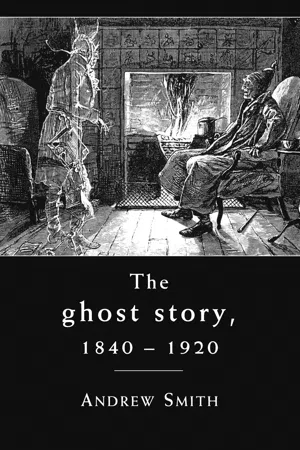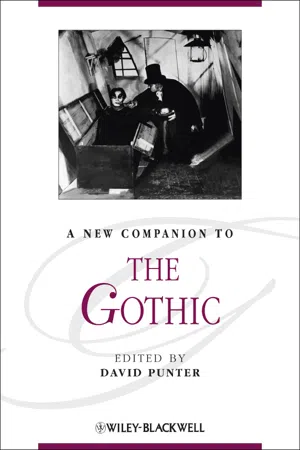Ghost Stories
"Ghost Stories" is a genre of literature that focuses on supernatural elements, often involving spirits, hauntings, and unexplained phenomena. These stories aim to evoke fear, suspense, and a sense of the unknown in the reader. They often explore themes of mortality, the afterlife, and the boundaries between the natural and supernatural realms.
8 Key excerpts on "Ghost Stories"
- eBook - ePub
- Martyn Hudson(Author)
- 2017(Publication Date)
- Routledge(Publisher)
...The remarkable ghost narratives of the Middle Ages were often based around the return of the corporeal dead, of the spectral hunt and of ghost armies (Schmitt 1998). The medieval ghost story was often didactic in intention, warning against sin and deeply enmeshed in orthodox religion (Joynes 2003). Jacqueline Simpson has long put forward the idea of the ghost as a corporeal walking corpse more akin to zombies than the ethereal floating ghosts of the Victorian story (2003), and the development of the ghost story as a historical genre has attracted some attention as it evolves through the centuries (Briggs 1977; Conrad-O’Briain and Stevens 2010). Both Simpson (1997) and M.R. James himself (1922) have remarked on the limited structures of the ghost story and certainly there is a commonality between the stories of James, Wharton, Northcote and James. Not only did they have personal contacts, but the Victorian milieu of haunted houses inherited from Dickens specifically was of importance to all of them. Dickens himself was profoundly influenced by the ghostly genre as it appeared in the Terrific Register (Ludlow 2010). There is a lineage and genealogy to the ghost narrative. Other writers like Kipling, E.F. Benson, Poe, Lovecraft and Le Fanu also made an important contribution to the evolution of the narrative and certainly there is still a continuing and profound interest in both fictional and actual hauntings. (See Harman 2012 on Lovecraft and the development of speculative realism.) There are six elements of the fictional ghost story that concern us here. Firstly, the stories are emplaced in geographical, topographical locations which are often quite thinly or not at all disguised. Secondly, haunting often takes place within and around material artefacts and often as a consequence of some over-curiosity or intervention around the artefact...
- eBook - ePub
American Women Short Story Writers
A Collection of Critical Essays
- Julie Brown(Author)
- 2014(Publication Date)
- Routledge(Publisher)
...The nineteenth century's sudden upsurge in the number of magazines published and in the size of the reading population ensured a demand for short fiction; an increase of leisure time for women of the upper and middle classes fed this demand and perhaps accounts for the burgeoning of literature by, for, and about women. The premise of the ghost story—that ghosts return from the grave—undermines a fundamental assumption about reality. Having unseated one assumption about the way things "must be," the ghost story frees authors and readers to question other constructs that they may previously have considered inviolate, among them the role of women in American culture. Subverting the ghost story to their own purposes, nineteenth-century female Gothicists went beyond their male counterparts' preoccupation with epistemology to address the (im)morality of the treatment of women in America, questioning what Ann Douglas and other historians have come to call the "Doctrine of the Two Spheres" and the "Cult of True Womanhood." Behind the veil of the supernatural, the feminist Gothicists protested the narrowness of women's roles and limitations on women's influence. Unlike Hawthorne, Irving, and Poe, who drew on a distant past and used exotic, explicitly Gothic settings, American women writing Ghost Stories placed their narratives in contemporary, realistic settings. It is particularly striking that these writers would choose to include a ghost—a most antirealistic device—in what are otherwise scrupulously realistic stories. Perhaps it is because these stories defy the categories invented by literary historians that these stories have largely been ignored. Especially significant in women's Ghost Stories is their depiction of the home. Far from being a safe haven, the home is a place of stultification, exhaustion, treachery, and terror. In Ghost Stories, women Gothicists portrayed a range of horrors attendant upon women's confinement to domestic pursuits...
- eBook - ePub
Contemporary Women's Gothic Fiction
Carnival, Hauntings and Vampire Kisses
- Gina Wisker(Author)
- 2016(Publication Date)
- Palgrave Macmillan(Publisher)
...If ghosts do not return to reveal crimes that have gone unpunished, the evil acts may in fact go unredressed. If ghosts do not appear to validate faith then faith remains just that. (Weinstock 2004, p. 6) Traditionally, the form of the ghost story has been one popular with women writers, perhaps because of the histories of hidden and silenced lives, the denials and the guilt, the repressions and the marginalisation, the domestic incarceration and the lack and loss of identity and power which have accompanied the roles of women, differently played out in different times and places. Ghost Stories allow the repressed, hidden histories to be seen and heard, and the incarcerated to break out. The walls of the Gothic enclosures of castles, mansions and everyday homes are cracked and undermined; fear and oppression exposed. Many women’s Ghost Stories from the nineteenth century speak to the late twentieth century and today: a revival. Women’s Ghost Stories offer the opportunity for the obliterated to reappear like the SSsss (shhhh) writing on the wall in Sarah Waters’ The Little Stranger (2009), and the long dead Cathar community who reappear to enable the visitor, Freddie, to help their story be found, their bodies discovered, in Kate Mosse’s The Winter Ghosts (2010). Traditional Gothic Ghost Stories by women often focused on entrapment, being walled in, hidden in castles, or physical danger, such as being threatened by ghost dogs, by revengeful predecessors and demon lovers. Contemporary women’s Ghost Stories recover the past and offer the opportunity to speak to those silenced by history, some of whom are representative of the ways in which societies outcast people who do not or cannot conform...
- eBook - ePub
Developing Thinking Skills Through Creative Writing
Story Steps for 9–12 Year Olds
- Steve Bowkett, Tony Hitchman(Authors)
- 2019(Publication Date)
- Routledge(Publisher)
...Once children understand the idea, they can use it to plot stories in other genres, plus pieces of nonfiction writing. We also aim to encourage the attitude that it’s fine for children to change their minds as they plan, because it shows further thinking and decision-making skills. – Characters. Here we introduce ‘character templates’ such as hero, villain and companion. We also look at character descriptions, plus touching on a few old-hat character situations that are best avoided. – Settings. Encouragement for the children to think beyond the usual settings for a ghost story. We also point out that the reader’s imagination fills in many of the details of a setting, so including just a few vivid descriptive details usually works better than writing long slabs of description. – Atmosphere. Tips for creating atmosphere in a ghost story, plus advice for distinguishing between different emotions such as nervousness, fear and terror. – Story starters 1 – plot suggestions. – Story starters 2 – opening scenes. Introduction Ghost Stories have been around for hundreds, if not thousands, of years and come from all over the world. They belong to the genre of horror fiction, which is part of the bigger category of supernatural fiction. Ghost Stories are usually meant to be scary, but they can also contain humour (such as the Scooby-Doo cartoons). Sometimes they are written or told to teach us something useful, acting as a kind of parable or morality tale. A Christmas Carol by Charles Dickens is a well-known example. The word ‘ghost’ comes from an old form of English meaning ‘spirit’ or ‘soul’. The word ‘haunted’ comes from an old version of French meaning ‘to visit a place often’, and may date back even further to the idea of ‘to settle’ or ‘be home’. Ask the children how they think this earlier meaning fits in with what is found in some Ghost Stories. What does a good ghost story contain? A ghost, obviously. But an effective scary tale doesn’t show the ghost too early...
- eBook - ePub
World Literature Decentered
Beyond the "West" through Turkey, Mexico and Bengal
- Ian Almond(Author)
- 2021(Publication Date)
- Routledge(Publisher)
...1 The Ghost Story Hayalet, Fantasma, Bhut But now that he was a ghost, he realized that his primary problem was that he was the past, not the present. –Hasan Azizul Huq, “The Agony of the Ghost” 1 A ghost story is usually about an interruption. One reality interrupts another, one musical performance disturbs another already in play. Two worlds, two times, bump into one another, sometimes antagonistically, sometimes collaboratively. In some texts, a struggle takes place as two different temporalities vie for control of the same building or person; in others, the two worlds merge and overlap harmoniously, content to mirror one another without intruding to the point of primacy. The idea of an interruption as the central premise of the modern ghost story or “episode” sits against a familiar critical background: that ghosts are a symptom of repression, that their presence – the way they leak into fiction, film, music and popular mythology – is somehow a consequence of massive psychic self-regulation, be it on a personal or societal level, an individual or collective memory. Lacan would say that we ourselves are the ghosts of our own body; our consciousness haunts the bag of fat, fluid and bone we are tenuously linked to. 2 Hence the idea of the ghost as a symbol of the “unsettled accounts” of the symbolic order 3 – the spectral, for both Lacanian theorists and deconstructionists, illustrates a certain, ever-elusive gap in the symbolic order, the ineluctable flaw inherent in every representational project. Over three decades of “spectral studies” have been concerned with identifying the ghostly with some form of repressed historiography, social tension or sexuality. The cultures we are talking about here do not have a common religious background...
- eBook - ePub
Paranormal Media
Audiences, Spirits and Magic in Popular Culture
- Annette Hill(Author)
- 2010(Publication Date)
- Routledge(Publisher)
...Ghosts, boggles, boggarts and wafts were prevalent in nearly every European culture during this period: ‘denied entry to the light of God, according to Christian tradition, they almost always appeared at night’ (ibid). There were Irish banshees, Hungarian vampires, German werewolves, and ghost dogs roaming the streets of Newcastle. Cautionary tales of spirits, demons and witches were part of rural traditions, connecting with temporal rhythms such as day and night, summer and winter, and also pagan festivals, such as All Hallows’ Eve and Midsummer Eve (ibid). A writer in the Spectator in the early 1700s commented: There was not a village in England that had not a ghost in it, the churchyards were all haunted, every large common had a circle of fairies belonging to it, and there was scarce a shepherd to be met who had not seen a spirit. (Cited in Ekirch 2005: 16–17) Ekirch notes ‘the late eighteenth century folklorist Francis Grose estimated that the typical churchyard contained nearly as many ghosts at night as the village parishioners’ (140). Historical Ghost Stories are moral tales. Some ghosts had a reason for returning to haunt the living, whilst others existed as a memorial for the dead. In 1660 the ghost of Robert Parkin appeared in the Westmorland parish church crying ‘Iam murdered, I am murdered, I am murdered.’ An enquiry was undertaken to restore justice to the victim (Davies 2007: 5). ‘Chapbooks with titles such as A Dreadful Warning to all Wicked Persons reinforced the message: murderers beware; the ghosts are out to get you!’ (ibid). Ghosts appeared in bedrooms warning loved ones of their departure from this world. Those who had not received proper burials haunted battle fields, bridges and parish boundaries. Stories of haunted highways were connected to the common practice of burying the bodies of suicides at crossroads in order to prevent the return of the unsettled spirit to the local community. A stake was driven through the heart of the corpse...
- eBook - ePub
The ghost story 1840 –1920
A cultural history
- Andrew W. M. Smith(Author)
- 2013(Publication Date)
- Manchester University Press(Publisher)
...5 Reading ghosts and reading texts: spiritualism So far we have focused on images of spectrality as they are manifested in literary narratives. However, the relationship between literature and the spectral can be given an additional critical turn through an exploration of spiritualism. The broad cultural context of spiritualism has been extensively explored but there is an under-examined strand within that culture concerning the literary imagination and textual interpretation. 1 The culture of spiritualism played an important part in shaping a language of spectrality which in turn informed literary representations of ghosts. However, this was not a one-way process and this chapter explores the interactive relationship between spiritualism and the literary culture during the late nineteenth to early twentieth century, and so provides an alternative exploration of the ghostly. Literature’s association with spiritualism is indicated by how various deceased writers became (allegedly) channelled through mediums during the period. There are spirit writings which purport to be from Shakespeare, Charlotte Brontë, Oscar Wilde, Joseph Conrad, and George Eliot, amongst many others. 2 In addition W.T. Stead, the investigative journalist and editor of The Pall Mall Gazette, also included in his Review of Reviews a special issue on ‘Real Ghost Stories’ which was published in book form in 1897. The appendix consists of a list of prominent individuals who had apparently been touched by contact with spirits and it includes a section on ‘Men of Letters’ which refers to the supposed spirit encounters of Petrarch, Dante, Goethe, Donne, Byron, Shelley, Thackeray, Elizabeth Barrett Browning, Maria Edgeworth, and Madame De Staël. 3 As we shall see, spirit messages were often decoded as if they were complex literary texts which required sophisticated critical exegesis...
- eBook - ePub
- David Punter, David Punter(Authors)
- 2012(Publication Date)
- Wiley-Blackwell(Publisher)
...But the prevalence of claustrophobia in Dickens, the foreclosure of escape from institution or destitution, the grotesque exaggeration of character and location, are all recognizably “Gothic” features, even as they play a crucial role in establishing whatever it is we mean by the category and stereotype of the “Dickensian.” Most historians of the Gothic would agree that a cluster of texts towards the end of the nineteenth century, by such writers as Stoker, Stevenson, Wells, and Wilde, constitutes a kind of Gothic renaissance, although quite why this should have been so has been subject to various interpretations. Many, again, would agree that the ghost story, in its classic Edwardian form, has some relation to the older Gothic. But beyond this, as we move into the twentieth century, we encounter, as we might expect, further fragmentation. Where might we – to take a particularly intriguing example – locate the “Gothic moment” in modernism? Or might we prefer to see in modernism precisely that movement of the mind that seeks to exorcise the ghost, to clean out the house, ruined though it may be, and assert the possibility of a life that is not haunted as it situates itself resolutely in a present that strains towards the future? Perhaps if we follow that line by acknowledging the way in which futurism itself came to stand as a fascinating and problematic specter on the scene of the twentieth century, we would be envisaging a response sufficient to suggest that matters are more complex, that exorcism is always fraught with difficulty and liable to produce a return of the repressed...
